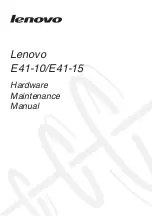
Part III: Appendixes
Glossary
303
hard disk:
A storage device composed of a rigid platter or platters that
can be magnetically coded with data. Hard disks hold much more
information than diskettes and are used for long-term storage of
programs and data. The primary (or only) hard disk in a computer is
usually fixed, but some computers have secondary hard disk that are
removable. By default, the hard disk is referred to as drive C.
hardware:
The physical, electronic and mechanical components of a
computer system, including devices such as a screen, disk drive,
printer, pointing device and processor.
hexadecimal:
The base-16 numbering system used by programmers to
represent binary numbers. Digits above 9 are represented by letters
(the 15 digits are 1, 2, 3, 4, 5, 6, 7, 8, 9, A, B, C, D, E and F). Two
hexadecimal digits are equivalent to the eight bits in a byte. For
example, F1 in hexadecimal is equivalent to 11110001 in binary.
See also
binary, decimal
.
Hibernation:
A feature of many Toshiba notebook computers which
preserves the current state of the computer, including all open files
and programs, when you turn it off by saving the information to the
hard disk. When you turn on the computer again, the system will
open to the same state it was when the system was turned off. See
also Standby and Resume Mode.
high-density diskette:
A 3.5-inch diskette that holds 1.44 MB of data.
high memory area:
The first 64 KB of extended memory.
hot key:
1)
A feature in which certain keys in combination with the
Fn
key can set system options or control system parameters, such as the
battery save mode. 2) A key or combination of keys that activates a
memory resident program.
hot swapping:
The ability to replace devices such as PC Cards, optional
modules or USB peripherals while the computer is turned on. Hot
swapping should
not
be attempted while the device is in use.
HyperText Markup Language (HTML):
A special coding scheme used to
prepare text and graphics for access over the World Wide Web.
I
icon:
A small picture that represents a function, file, or program.
Summary of Contents for 8100 series
Page 17: ...xvii ...
Page 24: ......
Page 55: ...Part I Getting to Know Your Computer Getting Started When and how to turn off the computer 29 ...
Page 111: ...Part I Getting to Know Your Computer Learning the Basics Caring for your computer 85 ...
Page 136: ......
Page 185: ...Part II Technical Reference Toshiba Utilities Expansion device properties 159 ...
Page 219: ...Part II Technical Reference Keeping Your Files Safe Hard disk drive passwords Windows NT 193 ...
Page 277: ...Part II Technical Reference Troubleshooting Guide Toshiba s worldwide offices 251 ...
Page 278: ......
Page 285: ...Part III Appendixes Hot Keys 259 ...
Page 286: ...Appendix B Built in features 261 Optional accessories and devices 268 Specifications 270 ...
Page 298: ...Appendix C ...
Page 308: ...Appendix E ...
Page 312: ......
Page 342: ...Part III Appendixes Glossary 316 ...
















































